USN Cold War Destroyers
Cold War US DDs:
Fletcher DDE class | Gearing DDE class | Gearing FRAM I class | Sumner FRAM II class | Forrest Sherman class | Mitscher class | Farragut class | Norfolk class | Charles F. Adams class | Spruance class | Arleigh Burke classThe story of US Cold War destroyers is a gradual evolution from WW2 legacy vessels to a modern missile-armed force capable of addressing any threat in the air, surface and underwater, with satellite communication and support in gound operations. A full overview from the Gearings to the Arleigh Burke, the current bread and butter of the USN in a post-cold war context of massive budget cuts. Early years were those of experiments on what could be fleet escorts for carrier strike groups, especially with the double threat of soviet bombers and submarines, with a floating period about types, cruisers, conventional destoryers or frigates, even proposals for an all-nuclear powered frigate fleet. Later years, with the soldification of missile destroyers (DLG/DDGs) and upscaling with the Spruance/Ticongeroga sharing the same hull and blurring the lines between destroyers and cruisers, to the late era of the Burke standard, true swiss knifes of the fleet without clear replacement planned right new. A fascinating saga over four decades including projects. Fletcher DDE, Sumner/Gearing FRAM, Mitscher, Forrest Sherman, Farragut, Charles F Adams, Spruance, Arleigh Burke but also the Typhon Frigates DLGN, and an overview of cold destroyer destroyer escorts (Dealey, Claud Jones, Bonstein, Garcia, Knox).
Genesis: WW2 lessons and new roles in sight
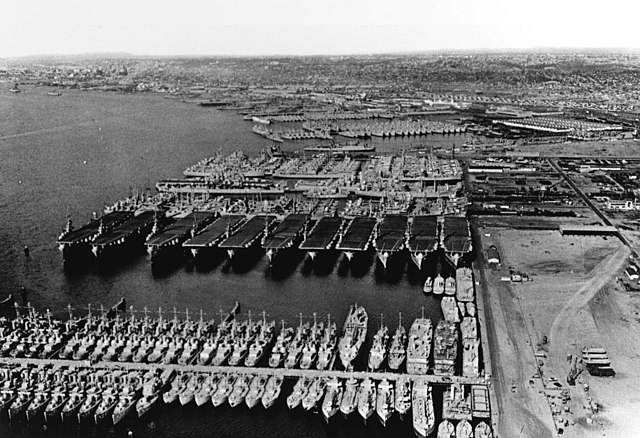
In September 1945, the US Navy had more than 200 destoyers in service, completed, or just launched, while the cancellation axed dozens even before V-Day. Operations reliaed on three major types, outside prewar vessels since 1934 which were clearly showing their age and design limitations: The Fletchers, Sumner and Gearing. The first were still “classic” vessels armed with two torpedo tubes banks and five single guns, of the standard 5-in/38. Their mass production, started in 1940 on a simplified version based on the previous Gleaves class soon became the largest destroyer construction program worldwide with 175 units launched until 1943.

The next Allen M Sumner class (1943) drew lessons of the early pacific and sacrificed a torpedo tubes bank for extra AA and three twin 5-in/38 in the new standard mount of the USN. Larger and still capable of 38 knots, they were succeeded in 1944 by the ultimate evolution of these WW2 designs, the Gearing class (pic, USS Chevalier) completed in 1945, and which class the most “axed” by cancellations, with more than 150 planned.
The latter were larger, longer, roomier, and offered potentially more potential for modernizations during the cold war, something which came very handy indeed: Between the FRAM I, II and many specialized variants created over the years, most of these vessels soldiered for more of the cold war. The amount of modifications was in many cases so staggering that they will be treated in standalone articles. Not only they worked tirelessely for the USN but after that often were resold to NATO countries and others around the globe, soldiering until the 1990s. The smaller Fletchers were not so lucky and their career often ended in the early 1960s.
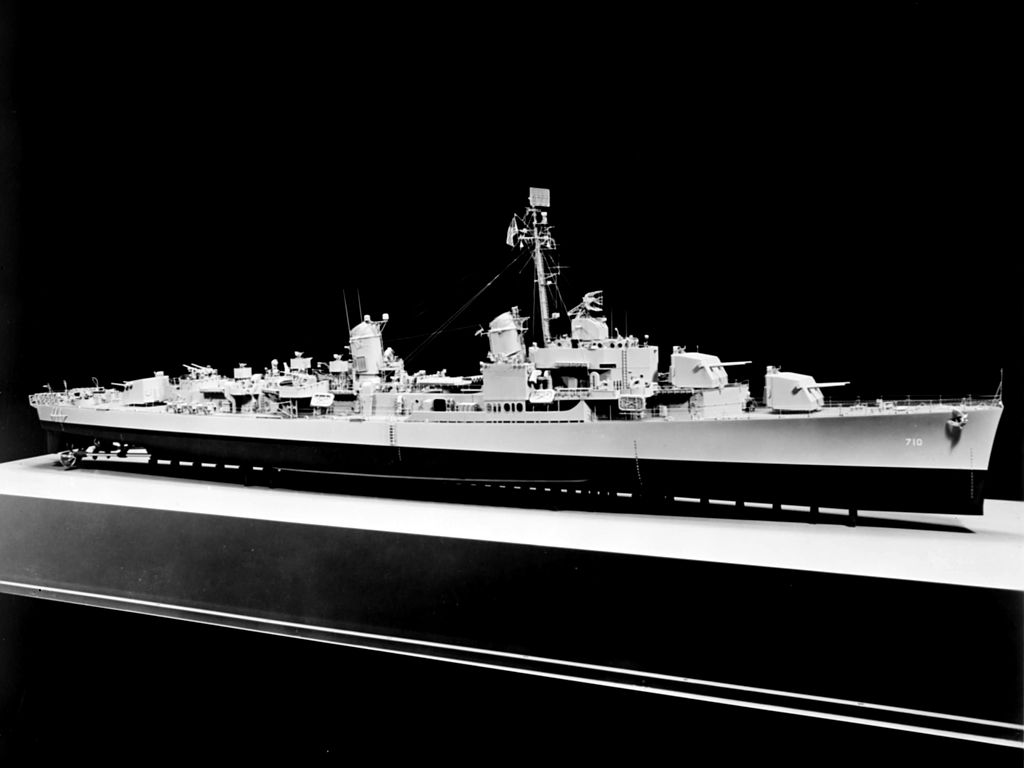
USN Tabula Rasa on Destroyers
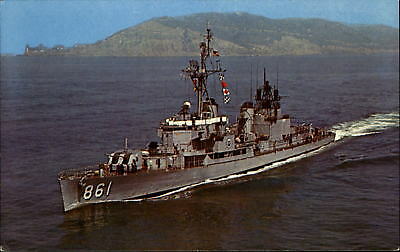 There was a great deal of debate and thinking about how to plan the next generation of destroyers. There were essentially two schools: Those who wanted the same versatile vessels able to perform a large variety of missions for the fleet, and those who wanted a more organic ship solely dedicated to the purpose of escorting the next task forces based on aircraft carriers such as the recent Midway class, planned USS United States and their successors, the super-carriers Forrestals. Protection of these assets was indeed a matter of organic specialization inside the task force: Since battleships were doomed on the not-so-long term, only saved by their recent construction, the bulk of organic AA defence rested on the cruisers, also tasked of anti-ship duties, while Destroyers were mainly tasked of ASW defense.
There was a great deal of debate and thinking about how to plan the next generation of destroyers. There were essentially two schools: Those who wanted the same versatile vessels able to perform a large variety of missions for the fleet, and those who wanted a more organic ship solely dedicated to the purpose of escorting the next task forces based on aircraft carriers such as the recent Midway class, planned USS United States and their successors, the super-carriers Forrestals. Protection of these assets was indeed a matter of organic specialization inside the task force: Since battleships were doomed on the not-so-long term, only saved by their recent construction, the bulk of organic AA defence rested on the cruisers, also tasked of anti-ship duties, while Destroyers were mainly tasked of ASW defense.
This task was already taken over by sub-chasers and frigates, corvettes, but the latter were merely seen as an inheritance of the battle of the Atlantic, to be only continued through the definition of new versatile frigates and the modernization of hundreds of existing escort destroyers. In 1947 a cold war with USSR was now evident and from the latter, the threat of fast submarines based on the German Type XXI was enough to guarantee a solid ASW buffer to the carrier forces. The development of missiles was also in the works, based on German experiments such as the V1, V2 or rocket-guided bombs, creating a new line of development, which was to emerge in the 1950s.
Cold War modernizations:

 Fletcher DDE
Fletcher DDE
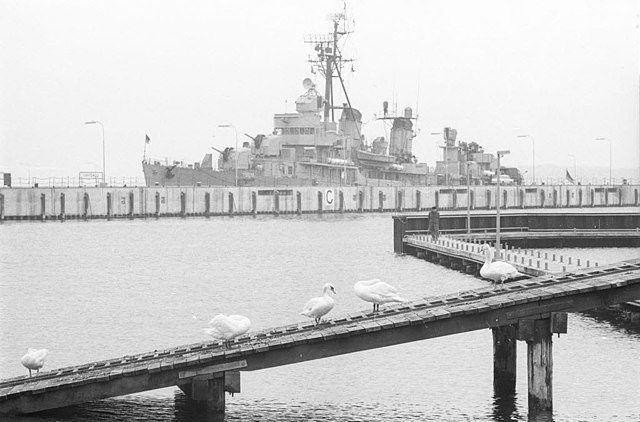
A Fletcher modernized in Bundesmarine service, here in Kiel
At the end of the Second World War, a total of nine Gearing class fleet destroyers were delivered incomplete; four were completed as the prototypes of a new generation of specialised ASW ships. Two of them, Carpenter and Robert A Owens, were intended as experimental (and temporary) substitutes for the ASW cruiser (CLK) Norfolk, with a heavy battery of two Weapon Alfa and a trainable Hedgehog, as well as four fixed torpedo tubes — and a gun battery limited to two twin 3in/50s (later 31n/70s). Two others, Basilone and Epperson, were completed as prototype escort destroyers, retaining two of their three twin 5in/38 mounts, plus one Weapon Alfa and two Hedgehogs (originally trainable, abreast the forward funnel; later fixed, on the 01 level forward), and four fixed torpedo tubes.
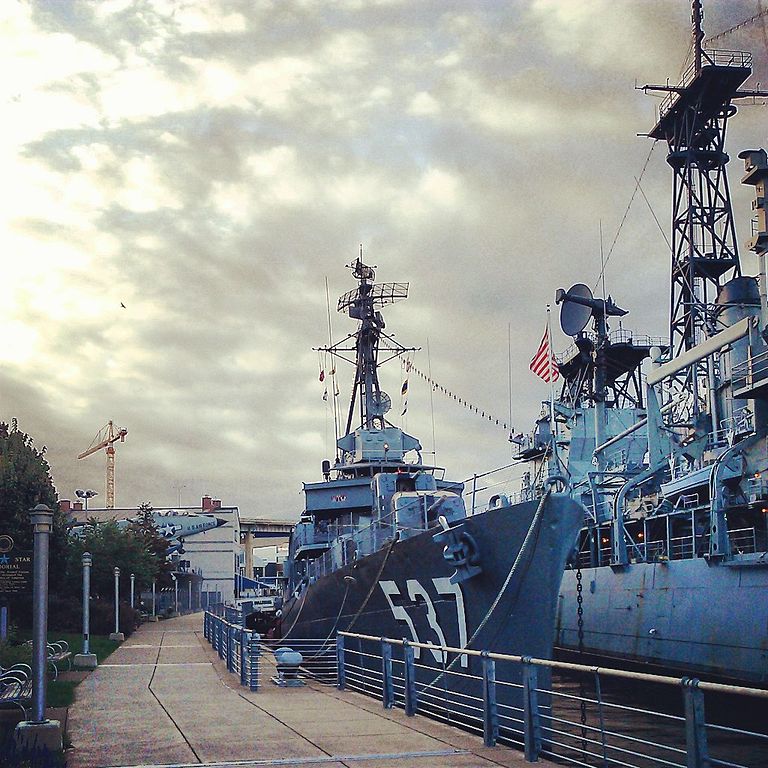
USS The Sullivans as preserved today. She became a National Historic Landmark in 1986.
Eleven other Gearings received limited ASW conversions as part of the formation of two postwar experimental Task Groups; in each case something comparable to Basilone was ultimately planned, but all that was done was the installation of a large trainable Hedgehog in place of No 2 5in mount, as well as the installation of a scanning sonar in place of the former searchlight type: DDE 818DDE 820, DDE 847 and DDE 871 in 1947, and DDE 764, DDE 765 and DDE 858-DDE 861 under the FY50 programme. Two more ships, Witek and Sarsfteld, had their No 2 gunhouses removed and were used for experiments; Sarsfield was a test ship for RAT, for example.
Although there were repeated proposals for DDE completion of the suspended destroyers, that was never done, and the DDE designation was dropped when all surviving Gearing received what ampunted to an ASW conversion under the FRAM program. It is only fair to note that in 1950 the navy adopted a policy of ASW improvement to all active fleet destroyers, to match the threat of a Soviet undesear fleet rather less developed than had originallt expected. The outward mark of this programme was a pair of Hedegehog on the 101 level level forward, less obvious but just as important was the provision of an improved sonar, first scanning type, the QHB and then the SQS-4.
 Gearing FRAM I
Gearing FRAM I
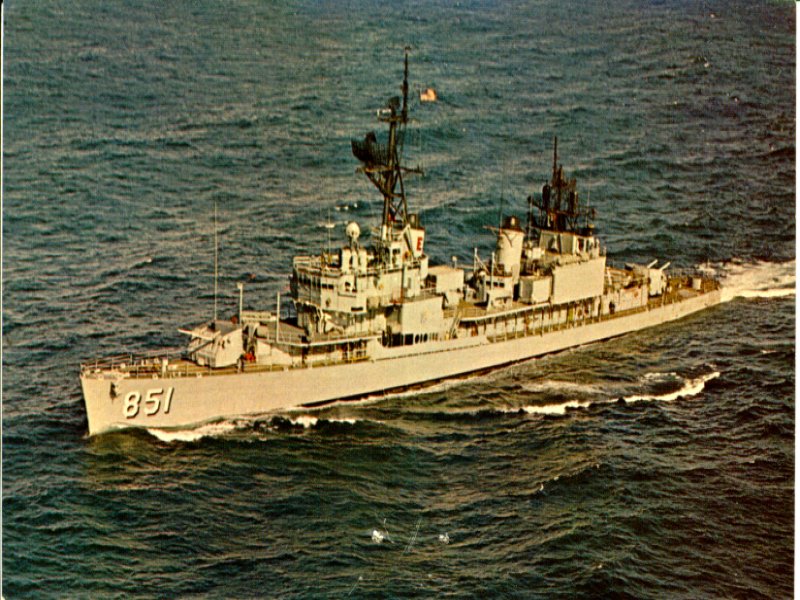
By 1958 the Second World War destroyers were beginning to wear out; FRAM was an attempt to extend their lives and so to put off the massive expenditure needed to replace them, in order to maintain the two hundred or more operational destroyers required by the US fleet of that time. In fact, the Vietnam War further delaved replacement, and even cut the one replacement programme undertaken (Spruance class), while wearing out the rebuilt ships, so that FRAM Gearings remained in (reserve training) service in 1982, more than a decade after their scheduled demise.

FRAM I, the most extensive reconstruction programme, was limited to Gearings and was expected to extend their useful lives by eight years. All shipboard components were rehabilitated, and one 5in mount and all lesser guns removed; ASROC, DASH triple ASW torpedo tubes were fitted, as well as the long-range SQS-23 hull sonar. The first eight conversions retained No 2 gunhouse and removed No 3, but it was argued that firepower should be better distributed, and most FRAM Is had 5-in guns fore and aft. The only Gearings not converted to FRAM I standard were sixteen FRAM II (six radar pickets, four former radar-pickets and six former DDEs), the experimental Witek, and the former missile conversion Gyatt.
As converted, these ships retained little modern anti-aircraft capability, particularly in view of increasing aircraft speeds. USS Higbee was bombed and her after 5in mount destroyed during a shore bombardment in the Gulf of Tonkin, 19 April 1972. Efforts were made to provide improved means of self-defence, and Sea Chapparal, which had been rejected as an alternative to Sea Sparrow, was tested aboard USS Floyd B Parks in May 1972. Later that year, eight other FRAMs were fitted: Anderson, Bausell, Gurke, Henderson, Mackenzie, Mason, Orleck and Tucker. All missiles were removed as ships returnedfrom South-East Asia the following year. Another special fit for Vietnamese operations was Shrike-onBoard (SOB), in which Shrike antradar missiles were fitted on launch rails atop the ASROC box launcher amidships, as a means of countering North Vietnamese coast defence radar. No details of ships fitted are available, and the system was installed on an emergency basis.
 Sumner FRAM II
Sumner FRAM II
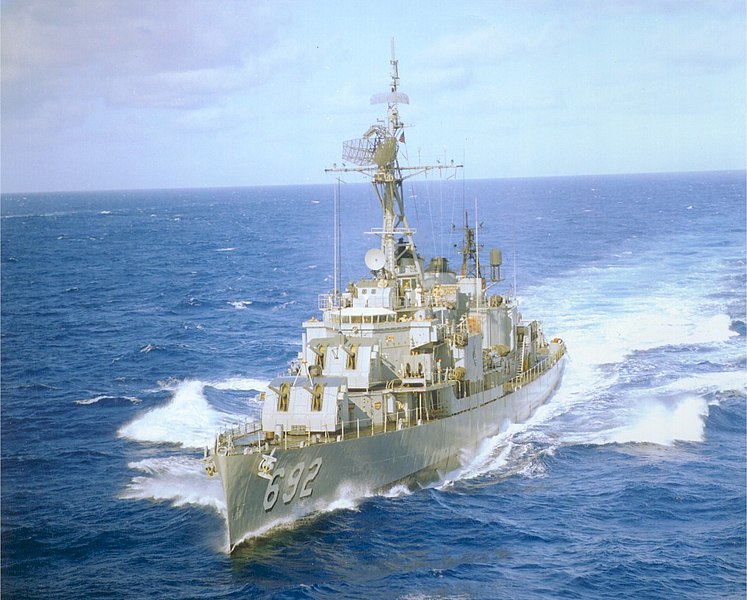
USS Allen M Sumner in 1967
FRAM II was originally intended to extend the useful lite of a destroyer by fve Years; It Was applied primarily to yy nprer class destroyers. All three 5in gin Mountings were retained, but a new bridge was fitted, together with a new tadar and ECM equipment. The existing SQS-4 sonar was retained but improved and relocated forward; it was supplemented by a variable depth sonar (VDS) operating from the same signal generator. Short (Mk 32) torpedo tubes were fitted but there was not enough space or weight for ASROC; instead these ships received the DASH drone and a pair of fixed long torpedo tubes (between their funnels) for Mk 37 torpedoes. That’s why they are also sometimes called and “austere conversion”.
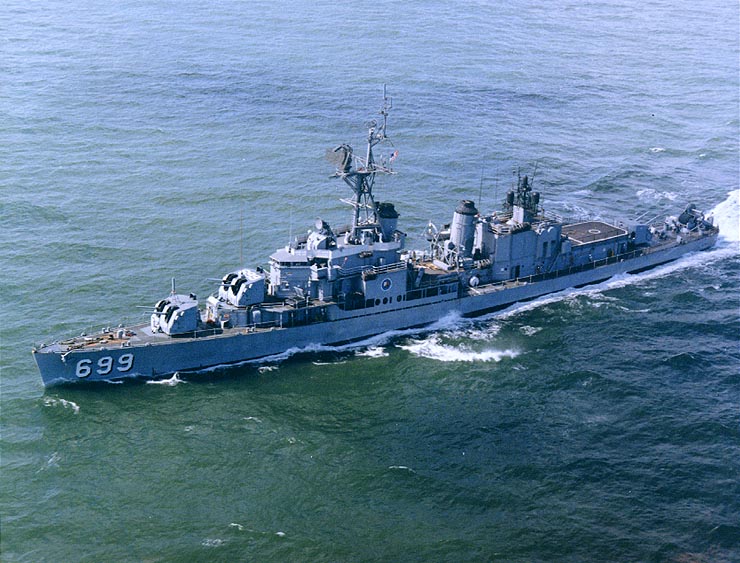
USS Waldron (DD(669) underway in 1964 as FRAM II

FRAM II plan – note, a dedicated post is planned in the future on the Fletcher DDE, and FRAM conversions.
As applied to USS Lloyd Thomas (DDE 764, 765 and DDE 858-861) class escort destroyers, FRAM II involved the retention of the trainable Mk 15 Hedgehog forward, with DASH aft and a pair of long torpedo tubes amidships; they also received the new SQS-23 sonar. The six ships retained as radar-pickets (DDR) received limited ASW refits since they were pri_ marily AAW ships: they retained their fixed Hedgehogs and received SQS-4 improvements and a variabledepth sonar, plus a new bndge and an enlarged CIC; new radars were also fitted. The former DDRs generally resembled Sumner class FRAM Ils, with long torpedo tubes and DASH, as well as all six 5in/38 guns.
The failure of DASH left these Ships without a long-range ASW weapon. Ironically, it had been proposed at one time to omit ASROC from FRAM I ships in view of the potential of the drone helicopter, but the rocket had been retained for all-weather capability.
 Mitscher class (1952)
Mitscher class (1952)
USS Mitscher, John Mc Cain, Willis A. Lee, Wilkinson
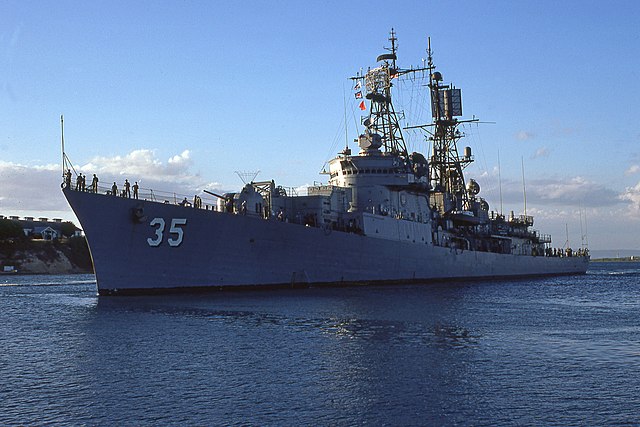
USS Mistcher in Cuban waters, 1975
The Mitscher class were four experimental large conventional destroyers, considerably larger than all previous one albeit more reasonable than the previous massive USS Norfolk (DL-1), earliest attempt of “fleet escort, destroyer”, cruiser-size. Due to their reclassifications as destroyers leaders (DL-2 to 5)they were not the first post-war destroyer class when commissioned in 1953-1954. They stayed in service until 1969 and the early 1970s but Mischer and Wilkinson were converted as guided missile destroyers (DDG) for more service years until 1980, in service with the Pacific and Mediterranean 7th and 6th fleets, John Mc Cain making a tour of duty in Vietnam.
 Forrest Sherman class (1952)
Forrest Sherman class (1952)
Forrest Sherman, John Paul Jones, Barry, Decatur, Davis, Jonas Ingram, Manley, Du Pont, Bigelow, Blandy, Mullinnix, Hull, Edson, Somers, Morton, Parsons, Richard S. Edwards, Turner Joy
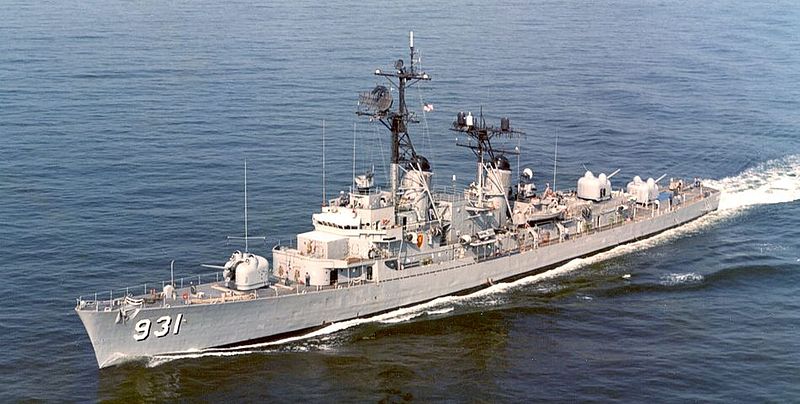
The 18 Forrest Sherman-class destroyers were many things: The first post-war US destroyers, successors of the legendary Gearing class, and the last conventional (all-gun-armed). They were commissioned from 1955, saw the Vietnam war aznd middle east crisis, some staying active until the 1980s. Armed with the 5-inch/54 caliber Mk42, they experienced dozens of modifications, four being converted to guided-missile destroyers (DDG) (prototypes for the Charles F. Adams-class), and eight as ASW vessels. Two are now preserved as museum ships, including the largely unmodified USS Edson, declared a national historic landmark in 1990.
They were truly “the last gunships”.
Development and evolution of missile Destroyers
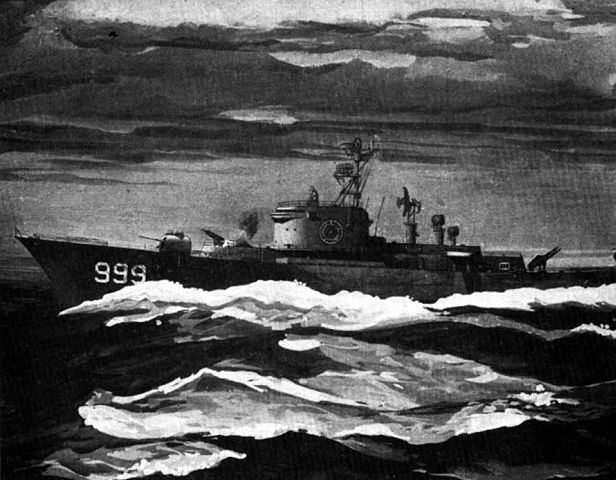
Now well known and indispensible NATO standard DDGs, missile destroyers were not something granted. If missile development started right before 1945. There were many WW2 experimentations such as the Bat missile built by the National Bureau of Standards, most sophisticated U.S. missiles of World War II. It was a glide bomb carried by a Navy PB4Y-2 Privateer as antiship/off-shore targets.). Still, it needed a propellant to be launched in a near-static way aboard a ship.
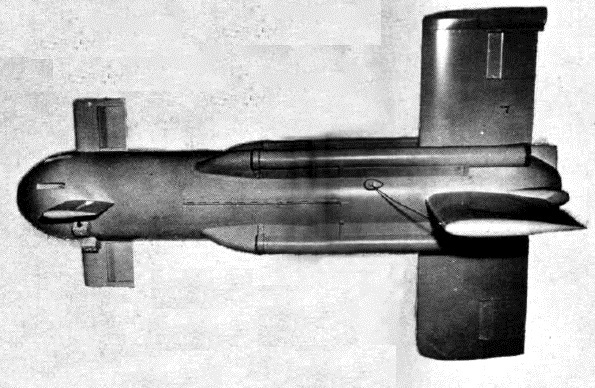
KAN Little Joe, an early ship-based anti-air missile (SAM) devevloped and built by the Naval Air Material Unit 1945-1946 (15 tested).
There were also the Cornelius XBG-3, Fairchild BQ-3, Fleetwings BQ-1 and BQ-2, Fletcher FBT-2, GB-1, Pratt-Read LBE (Glomb), GT-1, Interstate TDR, Interstate XBDR, JB-3 Tiamat, JB-4, KAN Little Joe, LBD Gargoyle, MX series, Naval Aircraft Factory TDN, Northrop JB-1 Bat, Pelican, Piper LBP, Pratt-Read LBE, Project Gorgon, Project Kingfisher, Republic-Ford JB-2, and Taylorcraft LBT 1 so a solid basis already. It’s mostly with Project Paperclip that the larger rocketry (especially ballistic missiles) took off; It should be stated that both the Navy and Air Force developed their own missiles on separate program, sometimes causing concerns at the Congress or for the MoD.
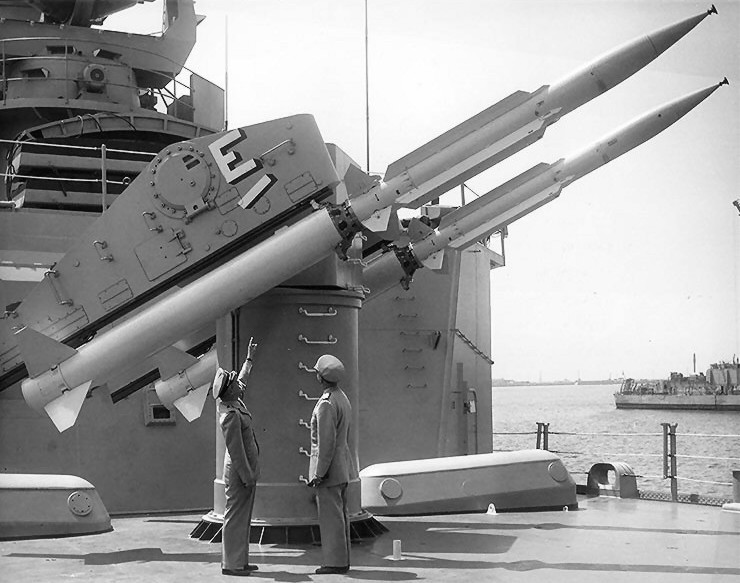
It’s really in the 1950s that the USN missile program eventually found its operational trio, the famous “T” (Talos, Terrier, Tartar). They all were SAMs essentially, with various ranges, but they were considered at first too large and complex to operate from a destroyers and instead, the latter were still seen as better for a traditional escort/ASW role. Meanwhile these 2nd generation missilkes entered service with cruisers, converted (Boston, Albany…) and fleet escort cruisers, the Leahy (initially classed as destroyer leaders), Belknap and later California/Virginia. Only the relatively nimble Terrier found its way eventually on large destroyers such as the Farragut class (4,100t, laid down 1957, service 1960, seen as predecessors to the Leahy) and the smaller, cheaper Charles F Adams class (3,270t, derived from the Forrest Shermans). The former proved that when well thought, a Terrier launcher can be installed on a destroyer. No need for an extensive belt conveyor system. The second confirmed that only the Tartar was suitable for true destroyers, even potentially on smaller ships, destroyer escorts and frigates. It was also helped by smaller, lighter electronics, in particular guiding radars. Even some Shermans were retroffited with single Tartar launchers (the smallest).
You might ask, why no antiship missiles on destroyers ? First off, they were simpler to make and in development from 1944 already, let’s cite the early cold war AUM-N-4 Diver developed in 1946. This one carried a torpedo and was the ancestor of the ASROC (see later). So to standardize uses it was found that using the massive Talos in antiship mode was actually easier to used in anti-ship role as the latter is a much more larger target, almost static. Alas, the Talos was reserved for cruisers, way too heavy to be used on destroyers.
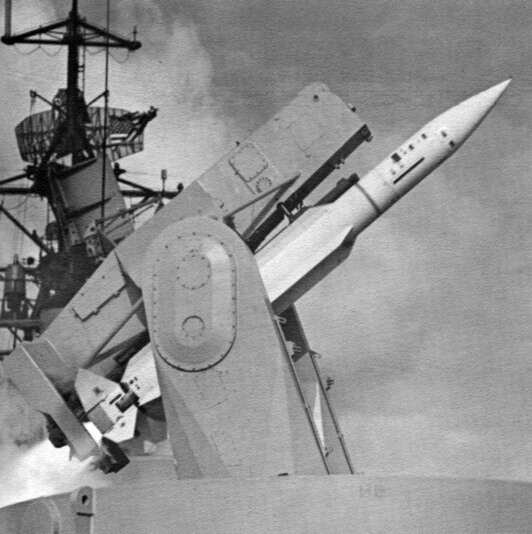
The RIM-2 Terrier and RIM-24 Tartar both lacked that capability, and when the existing Adams were upgraded to the RIM-66 Standard, or the Spruance class were introduced with it, they get back anti-ship capability. It was reconducted on the SM2. However this SM1/SM2 was small, relatively short range and lacked a large payload.
It would take a specialized anti-ship missile to counter Soviet’s own arsenal. And that was the A/R/UGM-84 Harpoon (1977). It was deployed mon many destroyers in a simple way, as the missile was fully autonomous and can be delivered and launched from a compact canister. Suddenly, a really efficicient, long range (75 nmi (139 km), at first, then double) weapon system can be liberally installed on destroyers still in service. The older Adams could be thus modernized in the 1980s with the RIM-66 Standard (SM-1) and Harpoon, both having antiship capabilities, or the large Spruance class, designed as ASW ships, that had the Standard and received both the Harpoon and Tomahawk, which also could be used against ships, and had even longer range.

RUR-5 ASROC on USS Farragut
And there was the ASROC. This missile was capable of carrying a torpedo for ASW longer range defence. It replaced the hegdehogs used until then, and could be fitted with the standard Mark 32 ASW homing torpedo, also always found aboard in triple banks. Eventually installed on over 200 USN surface ships, it was in theory able to carry (the missile carrier) another payload than the standard ASW torpedo, and potentially an anti-ship model. Alas, this system was never used in that role.
As of today, an Arleigh Burke class carried a formidable mission-based panoply in vertical launch systems: Harpoon, RIM-66M, RIM-156, RIM-174A, RIM-161 anti-ballistic missile, RIM-162 ESSM, BGM-109 Tomahawk and RUM-139 vertical launch ASROC, SeaRAM… Plus four models of acoustic torpedoes derived from the Mark 32. Each ship has at least one long, one medium and one short range antiship-capable missile. It’s no wonde the Budke represent today the very bulk, the core of the USN strike force alongside carriers, replacing both cruisers and frigates. They truly are versatile multi-mission “missile wagons”.
 Farragut class (1958)
Farragut class (1958)
USS Farragut, Luce, MacDonough, Coontz, King, Mahan, Dahlgren, William. D. Pratt, Dewey, Preble
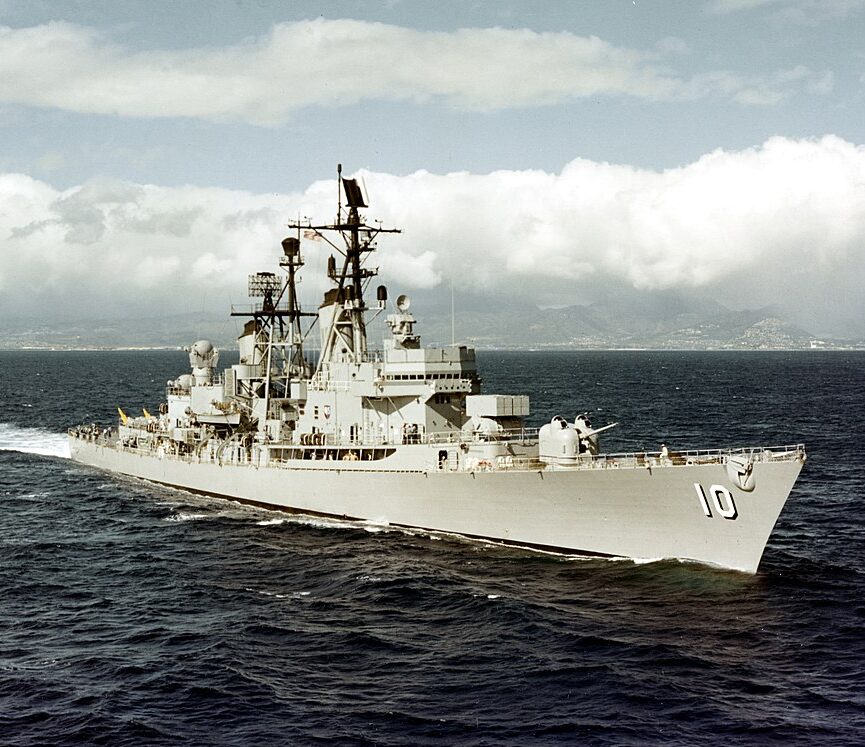
SS King off Oahu in September 1961, freshly commissioned
These ten large destroyers (DLG 6-15) sometimes referred to as the Coontz class, built between 1957 and 1959, were the first missile-launching escorts designed on plans in the US Navy. Their specifications dated back to the report made by the Schindler committee in 1954 which recommended the use of fast escort ships, armed mainly with fast guns for anti-aircraft combat, and smaller ASM means, as well as anti-ship torpedoes inspired by the memory of the battle of Samar (Leyte, 1944) where destroyers had stubbornly defended with torpedoes an imposing Task-Force of aircraft carriers against a Japanese fleet. The Terrier missile was not planned at the beginning and the role of the ASM defense was reinforced in front of the increasing threat of the fast Soviet SNA.
Their first ASM system was the RAT, followed quickly by the ASROC. The Farraguts took up the imposing flush-deck hull of the previous Mitschers, but were much heavier and larger. They received the NTDS in 1961, and ASROC reloads soon after, at the sacrifice of the two 76 mm mounts in 1969-77, as well as quadruple Harpoon missile ramps. Two vessels also received Vucan Phalanx rapid guns in 1973-75. The Mahan tested the SM-2(ER) in 1979 and their large dimensions allowed them to also implement the double-decker version of the tartar, replaced from 1983. These buildings were put in reserve in 1989-92. In 1990, eight were still in service.

Displacement: 3277t standard, 4526t FL
Dimensions: 133.20 oa x 14.3 x 4.6m
Propulsion: 2 shaft geared turbine, 4 boilers, 70,000 hp. 33 knts.
Crew: 330
Sensors:SPS29, 39, 2 SPG51, sonar SQQ23A.
Weaponry: 2 x 5-in DP, 1×2 Tartar SM1 (42), 1 ASROC ASM (16), 2×3 TLT ASM 324 mm.
 Charles F. Adams class (1959)
Charles F. Adams class (1959)
USS Charles F. Adams, John King, Lawrence, Claude V. Ricketts, Barney, Henry B. Wilson, Lynde McCormick, Towers, Sampson, Sellers, Robison, Hoel, Buchanan, Berkeley, Joseph Strauss, Conyngham, Semmes, Tattnall, Goldsborough, Cochrane, Benjamin Stoddert, Richard E. Byrd, Waddell
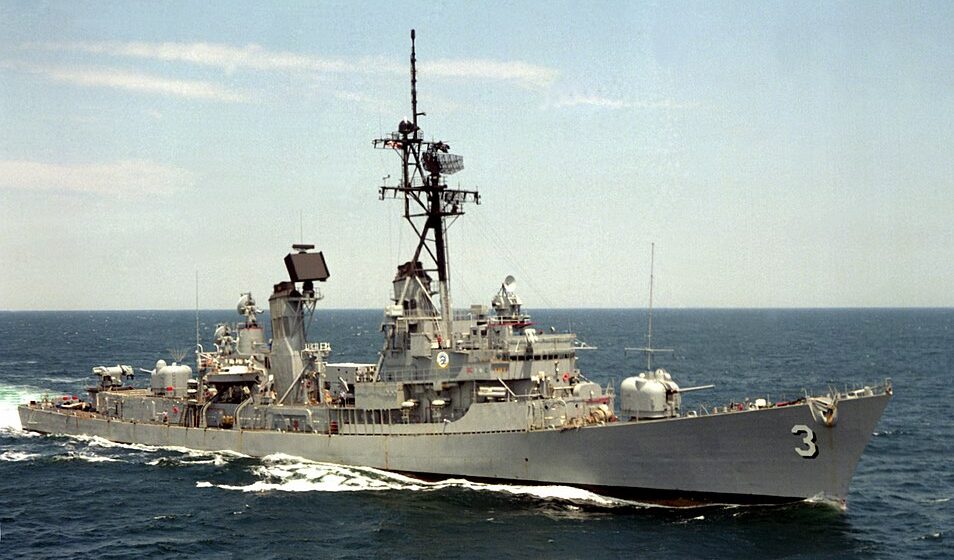
USS John King (DDG-3) underway in the Atlantic Ocea, 1983
The Destroyers of the Charles F. Adams class succeeded the Forrest Sherman (1953), themselves still modeled on the Gearing of the Second World War. Built in large series (23 units, DDG-2 to DDG-24; USS Waddell, DDG-24, was launched in February 1962 and accepted into service in 1964.), they retained typical characteristics such as the continuous deck hull, side bulwarks, two funnels, but they innovated considerably by being the first to implement a missile armament. The center of the system was the new MAA Tartar (SAM-1) which replaced the rear 127 mm DP turret. This system included a double launcher and a drum below equipped with 40 vectors.
This missile operational in 1962 and dependent on a very specific radar guidance system had a range of 50 km and a speed of Mach 1.8. The second system was the ASROC, promised a good career, both in the US Navy where it equipped all the escort buildings and abroad, and included an eightfold launcher placed in the center with a reload of 8 vectors. The missile, with a range of 9 km, a safe distance from the danger of torpedoing by an opposing submarine, carried an ASM load (10kt tactical warhead) or an acoustic torpedo with a load of 45 kg.
The Charles F. Adams, classified as “fleet escorts”, a term which highlighted the primacy of the aircraft carrier over the rest of the fleet, had been a technical tour de force because although 6 meters longer and more one meter wider than the Forrest Shermans, and still with the same propulsion system giving 70,000 hp, managed to maintain their speed of 33 knots thanks to a reduced laden weight. This was made possible by a lighter construction and a much longer hull, guaranteeing excellent hydrodynamic penetration.
The qualities of these ships were recognized and both the FRG and Australia built replicas. Nevertheless, their light construction and their narrow compartmentalization left little room for possible extensive work, and in fact, they were only superficially modernized (improvements in electronics, including the computerized tactical management system JPTDS, CME SQL 20/ 32 and the general-purpose Mk.86 fire control).
Their Tartar Mk11/13 launchers were fitted out in the 1980s to receive the Harpoon and they were fitted lastly with SPS40 and 52 radars. activity. Three were sold to Greece in 1992. They are still in service. Another was transferred to Australia to serve as spare parts reserves.
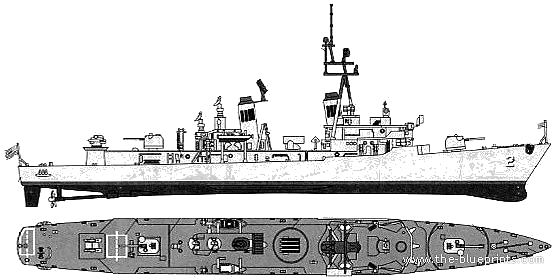
Displacement: 3,277 tons standard, 4,526t FL.
Dimensions: 133,2 x 14,3 x 4,6 m
Propulsion: 2 shaft steam turbines, 4 boilers, 70,000 hp 33 kts.
Crew: 333-350
Sensors: Radars SPS29, 39, 2 SPG51, sonar SQQ23A.
Weaponry: 2 x 5-in DP, 1×2 Tartar SM1 (42), 1 ASROC ASM (16), 2×3 TT ASW 324 mm.
 Typhon Frigates (DLGN) (1961)
Typhon Frigates (DLGN) (1961)
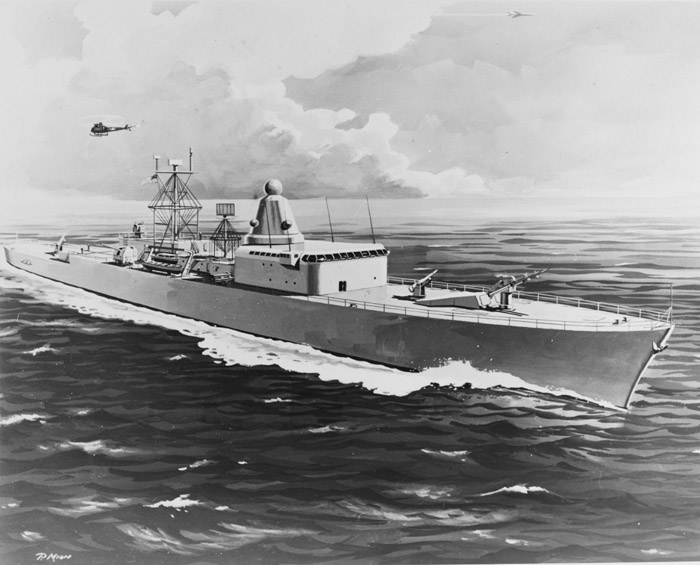
“TYPHON” Guided Missile Frigate (DLGN) by P. Mion of BuWeaps, September 25, 1961. The”TYPHON” missile system carrier was requested for the FY1963 shipbuilding program, but canncelled in turn when the missile system was. src
On 22 September 1961 secretary of defense Robert McNamara mounted budget assumptions for FY1963 which presented, due to the ongoing spendings for the war in Vietnam a dire spectacle. Navy needed a force of fifteen attack carriers and they were not nuclear powered. However approval was gained for a single nuclear-powered frigate, but austere and to be be used only when long range was needed (notably in times of war). This new design was built around the Typhon, a brand new and sophisticated weapon system intended to defend the carrier battle grpup against the latest missiles coming out (extected) by 1965. Like an early AEGIS it was to handle more targets and detect them at greater range, react more quickly, and required huge electric power.
So a nuclear-powered guided missile frigate made sense, both for the range and power this hungry syttem. Computers at that time were bulky and very energy-heavy, most of which was dedicated to cooling. The future medium-long range Typhon SAM was also SSM and even anti-missile and would required a single multi-purpose radar for all tasks.
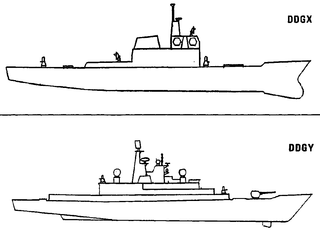 However as the program progressed, the navy shifted its attitude toward nuclear propulsion for surface ships, notably by early reports from USS Long Beach and USS Enterprise and eventually both the secretary of the navy and CNO entered a collision course with the secretary of defense on that chapter. Still, Enterprise, Long Beach, Bainbridge proved nuclear propulsion and plant reliability still, and the Navy and AEC supported nuclear propulsion for new major surface combatant above 8,000 tons as acted by the CNO on March 28, 1962. This included all future “frigates” notably the lead Typhon FY1965 and two more guided missile destroyers FY1968.
However as the program progressed, the navy shifted its attitude toward nuclear propulsion for surface ships, notably by early reports from USS Long Beach and USS Enterprise and eventually both the secretary of the navy and CNO entered a collision course with the secretary of defense on that chapter. Still, Enterprise, Long Beach, Bainbridge proved nuclear propulsion and plant reliability still, and the Navy and AEC supported nuclear propulsion for new major surface combatant above 8,000 tons as acted by the CNO on March 28, 1962. This included all future “frigates” notably the lead Typhon FY1965 and two more guided missile destroyers FY1968.
The Typhon radar was power hungry and eventually only a cruiser had the required power, if back to conventional so it was eventually aliminated from DDG and DLG (destroyers and frigates). The Navy downgraded the project to a Medium-Range version and conventional radar, but it was rejected ands ultimately the DDG grew to 8,000 tons, even with the smaller 3400 element radar, and conventionally powered with the long and medium-range Typhon. Nuclear powered was adopted firmly by late March, the DDG discardfed and swapping to a DLGN (cruiser). There was a last proposal for a conventional CONAG powered ship but cost was already above the pure nuclear solution over a DLGN which hull reached 600 ft (180 m) in 1962.
However soon the Bureau of Naval Weapons (BuWeap) found the Typhon system far more difficult to develop and by May 1962 it was proposed to adopte a new Bainbridge instead (which became USS Truxtun) and an oil-fired Typhon was pushed to the FY1964 program, until the navy accepted a single-reactor destroyer with modified Typhon.
By November 1962, the Secretary of the Navy requested from Congress to cancel the Typhon cruiser FY1963 and instead fund the 3T Get Well Program. Reports indeed precised that completing the system on time plus the cost associated were the reasons for it. On 26 November, McNamara cancelled in turn the Typhon frigate, but without substitutes. The Navy wanted then a “third Bainbridge” and to reallocate funds to improve the Terrier, Talos, and Tartar. Final cancellation for the Typhon was acted on 7 January 1964 by Robert S. McNamara. Still, the radar was tested meanwhile in Norton Sound and all this data would be later useful for the base of the new AEGIS system anyway.
Displacement: 10,000 tons standard, 12,000 FL.
Dimensions: 198.2 x 19.5 x 6.4 m (650 ftwl x 64 x 21 ft)
Propulsion: 2 shaft nuclear, 2 D2G reactors, c30 kts.
Crew: 743
Sensors: Radars SPS-49, SPG-59, sonars SQS-26, VDS.
Weaponry: Long range Typhon SAM (60+20 ASROC), 2×3 Mk32 ASWTT, 1x 5-in/38.
 Spruance class (1975)
Spruance class (1975)
USS Spruance, Paul F. Foster, Kinkaid, Hewitt, Elliot, Arthur W. Radford, Peterson, Caron, David R. Ray, Oldendorf, John Young, Comte de Grasse, O’Brien, Merrill, Briscoe, Stump, Conolly, Moosbrugger, John Hancock, Nicholson, John Rodgers, Leftwich, Cushing, Harry W. Hill, O’Bannon, Thorn, Deyo, Ingersoll, Fife, Fletcher, Hayler
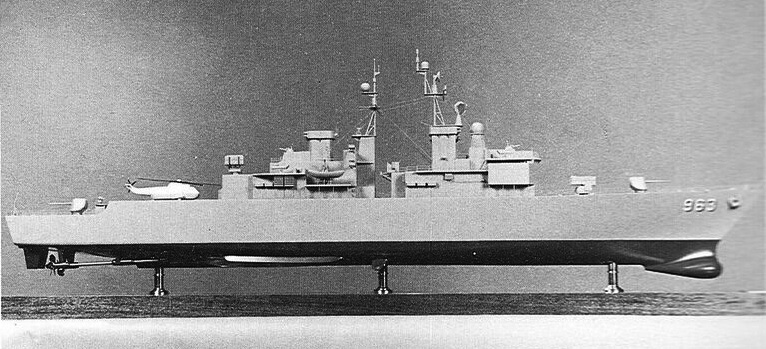
The origin of the program dater back from the Vietnam war. It was realized that the old FRAM WWII era Sumner and Gearing leftovers were no longer credible as a naval asset in ths current changing events, they were small at 3,500-4,000 ton and only carried a 8-cell ASROC, four obsolete 5-inch/38 guns, two triple Mk32 ASW torpedo launchers, the staff considering “sitting ducks” to anti-ship missiles. They were limited also in their ASW capabilities (their only saving grace), lacking proper helicopters (the failure of DASH made them even less relevant than Frigates like the Knox class) and still, they packed some 400 sailors in poor living conditions going back to 1942 emergency wartime specifications. Morale was low, capabilities were poor and yet they were still costly to operate, and had been costly to upgrade. It was more than time to replace them, as soon as possible.
 Arleigh Burke class (1990)
Arleigh Burke class (1990)
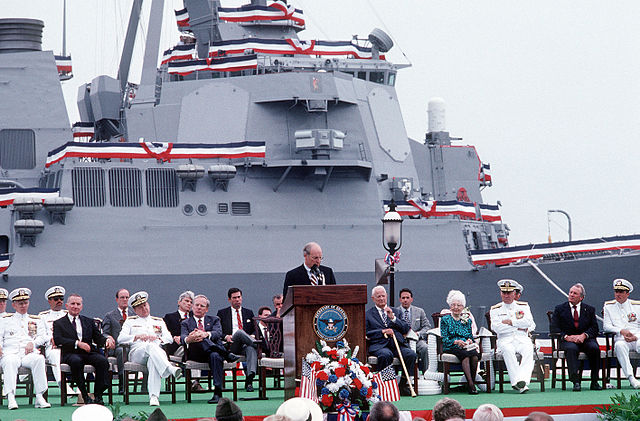
Commission ceremony of the lead vessel headed by MoD sec. Dick Cheney in 1991.
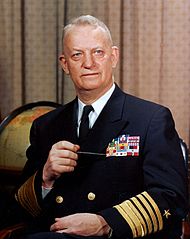 With 92 ordered, 72 in service today, the Arleigh Burke class is the largest destroyer series since WW2, anywhere. For a design to stay relevant from early studies in the mid-1980s when the cold war was warming up, to this day of great uncertainty, four successive “flights” (variants) kept it updated with tbe latest in electronics and weaponry. Since it’s a bit off-topic for the cold war, we will focus here (like in the future article) on its development process. USS Arleigh Burke indeed entered service on 4 July 1991, so technically months before the dissolution of USSR, generally regarded as the end of the cold war (16 December).
With 92 ordered, 72 in service today, the Arleigh Burke class is the largest destroyer series since WW2, anywhere. For a design to stay relevant from early studies in the mid-1980s when the cold war was warming up, to this day of great uncertainty, four successive “flights” (variants) kept it updated with tbe latest in electronics and weaponry. Since it’s a bit off-topic for the cold war, we will focus here (like in the future article) on its development process. USS Arleigh Burke indeed entered service on 4 July 1991, so technically months before the dissolution of USSR, generally regarded as the end of the cold war (16 December).
Development started in 1974, when previous CNO and admiral Elmo Zumwalt looked to a new destroyer type at less cost to replace the older Adams, Mitscher, and Farraguts FY 1990. The project was delayed and downgraded even further compared to Spruances, it was decided in the early 1980 of the absence of an helicopter and shorter hull. The basic idea was to have a mix of a few high-end, high-cost warships supplemented by many low-end, low-cost warships, and the new class would fit the bill, whereas the high end vessels ended as the Ticonderoga class.
Engineers made the best use of the limited hull and managed the impossible as the design evolved, with large, water-plane area-hull form, wide flaring bow, improving seakeeping ability and allowing high speed in high sea states. It was even considered better than the Spruanced in that regards but it was necessary to keep stability while the suprestrructures were reverted to steel instea of aluminium. The class also incorporated early stealth techniques, which were a first as well. The technical development was approved in 1986, contract was reached with a yard, Bath Iron Works at Bath, Maine on 6 December 1988 for the first keel laid down. Venerable, superstar New York based ship design company Gibbs & Cox was awarded the contract for her design.
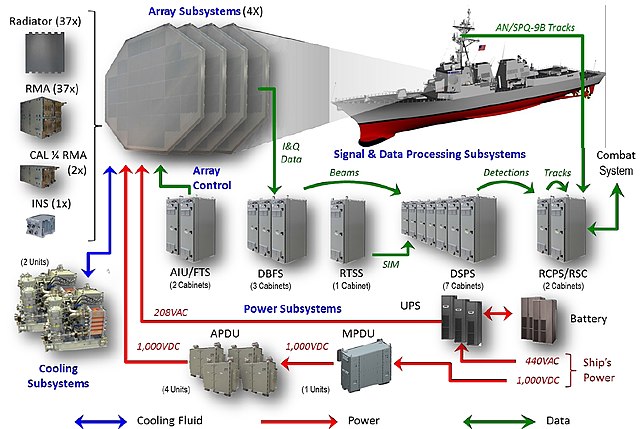
Technically one of the greatest aspect of the class was to be AEGIS-capable unlike the previous Spruance and thus, take the role of the Ticonderoga class cruisers as well. Unifying both the two types into an ideal fleet escort, smaller, more automated and so more economical on the long run, well suited to post-cold war budget restrictions with a full crew of 280 (compared to 330 on a “Tico”). The centerpiece of the desgign was the new, slightly smaller and downgraded version of the Aegis Combat System, which was improved over the years to surpass the original system.
It was still capable of providing the destroyers with Aegis plus the new SPY-1D multi-function passive electronically scanned array radar, the abaility to track 200 targets simultaneously.
Still they had to have a 50-foot shorter hull than the Tico/Spruance but with a wide flaring bow and the initial 80,000 shp LM2500 gas turbines were later upgraded.
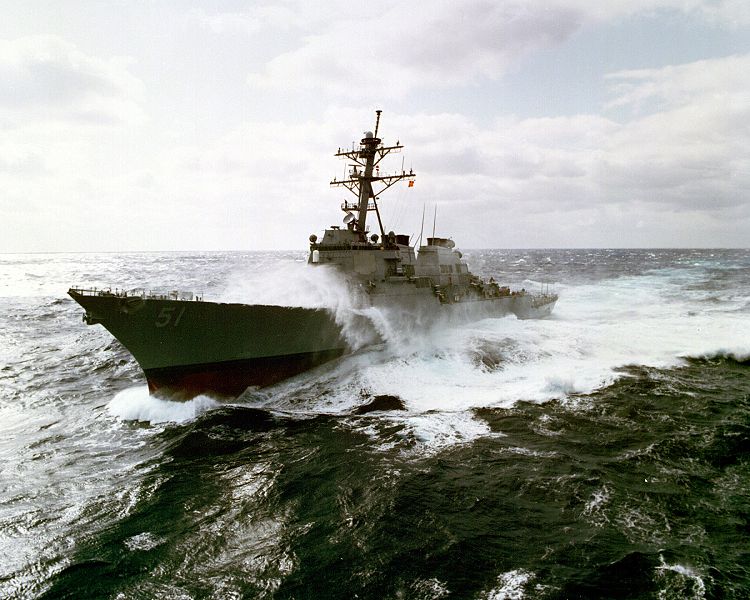
The Burke had not only a stealthy hull, but it as tailored for the worst sea conditions, and managed to do better than the larger Spruance in that regard.
Armament started modestly, without any main gun, later a single OTO Melara 76 mm, and eventually setlling on a 5-inch/54-caliber Mark 45. Quad Harpoon canisters were planned from the start, but not necessarily a VLS, instead a single twin SM-1 standard was to be standard with c40 missiles, inclusing ASROC. It’s only with lessons retained from the Ticonderoga that the project evolved to include a vertical cell launcher. The concept was introduced for the new class, and adopted first by the CG-52–73 Ticonderoga cruisers, with instead of classic twin arms launcher, slow to reload, 61 cell Mk 41 vertical launch systems containing a mix off missiles. The core idea was to have a universal launcher and so to be able to give any commander of large choice of missile assets in order to deal with any threat.
On the Burke class, this means the RIM-66M, and RIM-156 surface-to-air missiles, RIM-161 anti-ballistic missile, BGM-109 Tomahawk cruise missile and RUM-139 vertical launch ASROC. Two cells were installed, one forward, with 61 cells and one aft with 29 for 90 total. They were complemented by two Mk 141 Harpoon anti-ship missile launcher and a SeaRAM CIWS in complement to the onboard artillery, 5-in/54 Mk.45 main gun and a Phalanx CIWS, two of the new 25 mm Mk 38 machine gun system and two venerable Browning 0.5 HMGs to deal with asymetric threats.
Particuliar attention was given to passive (Kevlar plating around the Central Command Center) and active protection and ensemble comprising the AN/SLQ-32 electronic warfare suite, AN/SLQ-25 Nixie torpedo countermeasures, Mk 36 Mod 12 decoy launching systems, Mk 53 Nulka decoy launching systems, and Mk 59 decoy launching systems for a full coverage against any type of threat, cruise and antiship missiles as well as torpedoes. The scale of this bubble was even pushed further with the next flights.
Electronics wide, these ships pushed the enveloped with a classic set and new additions, on caracteristically slanted masts, carrying the following:
-AN/SPY-1D PESA 3D radar
-AN/SPS-67(V)3 or (V)5 surface search radar (DDG-51 – DDG-118)
-AN/SPS-73(V)12 surface search/navigation radar (DDG-51 – DDG-86)
-Three AN/SPG-62 fire-control radar
Mk 46 optical sight system
AN/SQQ-89 ASW combat syste, comprising the AN/SQS-53C sonar array, AN/SQR-19 tactical towed array sonar and AN/SQQ-28 LAMPS III shipboard system.
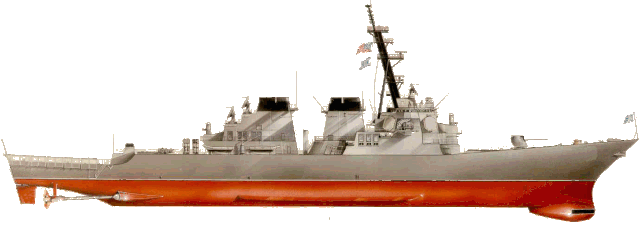
Flight I profile (cc)
⚙ Arleigh Burke, Flight I 1991 specifications |
|
| Displacement | |
| Dimensions | 505 x 59 x 31 ft (154 x 18 x 9.4 m) |
| Propulsion | 2 shafts 4× GE LM2500-30 gas turbines 100,000 shp (75,000 kW) |
| Speed | 30 knots (56 km/h; 35 mph) |
| Range | 4,400 nmi (8,100 km; 5,100 mi) at 20 kn (37 km/h; 23 mph) |
| Armament | 1× 5-in mk 45, 20 mm Phalanx CIWS 2× 25 mm Mk 38 MGS, 4× 0.5 in HMG, 2× Mk 141 Harpoon, 1× SeaRAM CIWS 29-cell, 61-cell Mk 41 VLS, 2× Mark 32 TTs |
| Active Protection | Kevlar CiC, AN/SLQ-32 EWS, AN/SLQ-25 Nixie TCM Mk 36 Mod 12, Mk 53 Nulka, Mk 59 decoys. |
| Sensors | AN/SPY-1D PESA 3D radar, AN/SPS-67(V)3 SSR, AN/SPS-73(V)12 SSNR, 3× AN/SPG-62 FCR Mk 46 OSS, AN/SQQ-89 ASW combat system |
| Air Group | 1 Sikorsky MH-60R |
| Crew | 33 com. officers, 38 chief petty officers, 210 ratings |
Flight II to III:
Improvements were not long in coming and led to the Flight II, IIa and eventually III.
–Flight II ships started FY1992 with the new AN/SRS-1A(V) Combat Direction Finding enhanced detection of signals as well as TADIX-B, JTIDS Command and Control Processor, Link 16 for communication, SLQ-32 (V)3 suite, SPS-67(V)5 surface search radar and introduction of the SM-2ER Block IV plus greater fuel capacity.
–Flight IIa was ordered FY1994, two hangars for ASW helicopters and the Cooperative Engagement Capability (CEC), and the Kingfisher mine detection system. For passive protection, five blast-resistant bulkheads were added inside the hull, length was increased, SPY-1D arrays were relocated higher, the aft VLS had six additional cells, new propellers were introduced, New fiber optics, new Harpoon missile launchers, a forward Phalanx CIWS, and later AN/SQR-19 TACTAS. Next from DD-81, the new 5-inch/62 Mark 45 Mod 4 was installed and from DDG-87, BridgeMaster E nav radar, composite hangars, shrouded exhaust funnels (from DDG-89 onwards). From DDG-91, the improved SPY-1D(V) radar was adopted. Some ships obtained the AN/WLD-1 Remote Minehunting System (RMS) as well. Meanwhile modernization was launched for Flight I and later II ships in the 2010s.
–Flight III ships When the CG(X) program wa scancelled, a program started to start production of the Flight III design, FY2013 with 24 on order, FY2016 to FY2031. It was geared to the Air and Missile Defense Radar (AMDR), IAMD role initially proposed for CG(X), potential replacement for the Ticonderoga. The Flight III AMDR AN/SPY-6 was reduced in diameter to 14 feet (4.3 m) and used an active electronically scanned array with digital beamforming, said by the contractor to the 30 times more sensitive and fulluy integrated in the Aegis Baseline 10. Extra cooling needs urged the replacement of the inflatable boats bay and Halon fire suppression system with lighter water mist system but also strengthening of the hull.
In the end, as this is written, 42 Flight III ships were ordered for a grand total of 117 ships forthe Arleigh Burke class, the last delivered well past the 2038 mark.
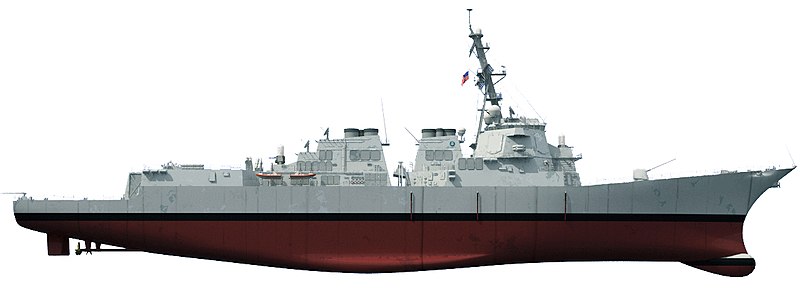
Flight IIA profile
⚙ Arleigh Burke, Flight III 2024 specifications |
|
| Displacement | 9,700 long tons (9,900 t) |
| Dimensions | 509.5 ft (155.3 m), same |
| Propulsion | 4× GE LM2500 GT(4x 26,250 bhp), 3× RR AG9160 Gen. (5,400 hp): 105,000 bhp (78,000 kW) |
| Speed | 30+ knots (56 km/h; 35 mph) |
| Range | Same |
| Armament | 5-inch/62 Mk 45 Mod 4, 1×20 mm Phalanx CIWS, 2× 25 mm Mk 38, High Energy Laser, 1× 32-cell, 1× 64-cell VLS Mk 41, 2x TTs |
| Protection | 130 tons of Kevlar splinter protection around vital areas |
| Sensors | AN/SPY-6(V)1 AESA 3D radar, AN/SPQ-9B SSR, BridgeMaster E NavR, 3xAN/SPG-62, Mk 20 EOSS, AN/SQQ-89 CS |
| Air Group | 2x hangars, 2x MH-60R Seahawk LAMPS III |
| Crew | c23 officers, 300 enlisted |
 DDG(X) class (2030+)
DDG(X) class (2030+)
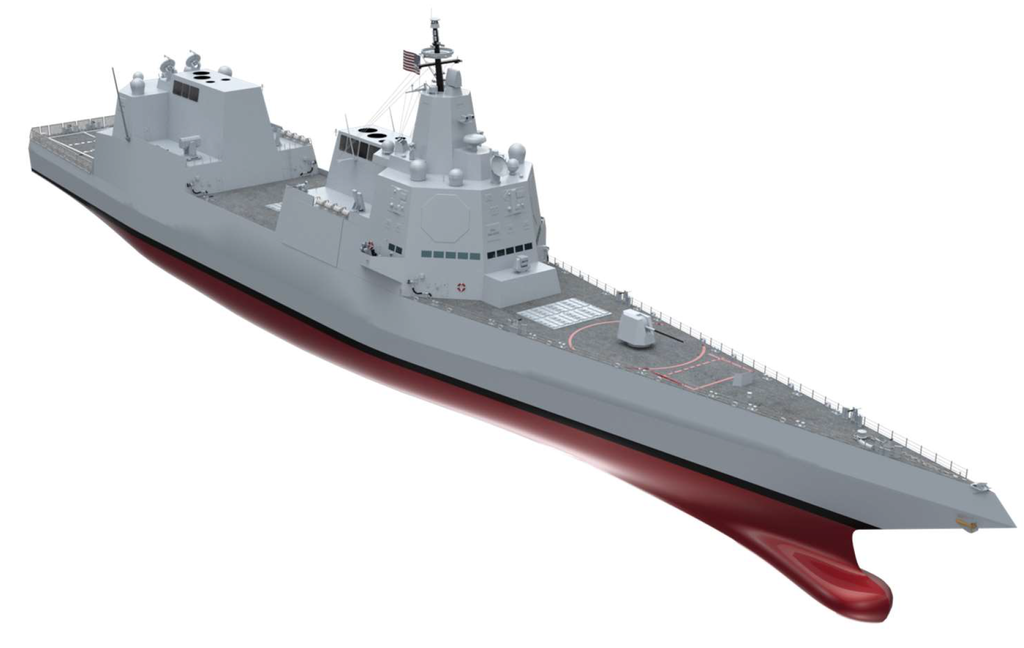
DDG(X) concept as of 2022.
Apart the “white elephants” that were and still are the Zumwalt class in the 2000s, now acting more as cruisers than destroyers and for which the program never arrived to its conclusion, the Navy started working on a future destroyers that could integrate lessons from the “Zum” design while being resized more like an Arleigh Burke and less costly obviously. By April 2014 development of the “Future Surface Combatant” started, with an entry into service slipping from 2030 to 2032 today. At tfirst they were to complement the Flight III Arleigh Burke and should carry high energy lasers, extra onboard power-generation systems and much increased automation, as well as all next-generation weapons, sensors and electronics.
The design also borrows from innovations found on the littoral combat ships and Gerald R. Ford carrier. Zumwalt’s electric drive system coupled with 58 megawatts are required for the new class, and extra modularity to make upgrades of all kind cheaper and faster. The DDG(X) program had been scheduled, firmly FY2032. Apart some initial 3D renderings this is still very early in development, so no specs are expected other than the following estimations:
13,290 long tons (13,500 t) standard, meaning probably 200 m (656 feet) in lenght overall, Integrated Power System for propulsion 150-200,000 kw or more, the AN/SPY-6(V)1 AESA 3D radar, AN/SPQ-9B surface search and fire-control radar and AN/SPG-62 fire-control radar
The Armament for now is at least to comprise a 5-inch (127-mm)/62 cal Mk 45 Mod 4, three 32-cell Mark 41 Vertical Launching System (VLS) (96 but swappable with larger VLS systems) and two 21-cell for the RIM-116 Rolling Airframe Missile launchers, the same good old Mark 32 Surface Vessel Torpedo Tubes, but above all the 150/600kW lasers to replace CIWS, already tested.
There will be a flight deck wit two enclosed hangars, and perhaps a derivative of the Bell V-280 Valor for the Navy (in discussions) albeit it’s width is not compatible with the hangar as now. In addition the Navy signed the FVL (MS) program on 8 November 2019, to replace the MH-60R/S and MQ-8C fleet. Bell proposes its V-280 but also the smaller Bell V-247 drone which could fit inside a double hangar.
Read More/Src
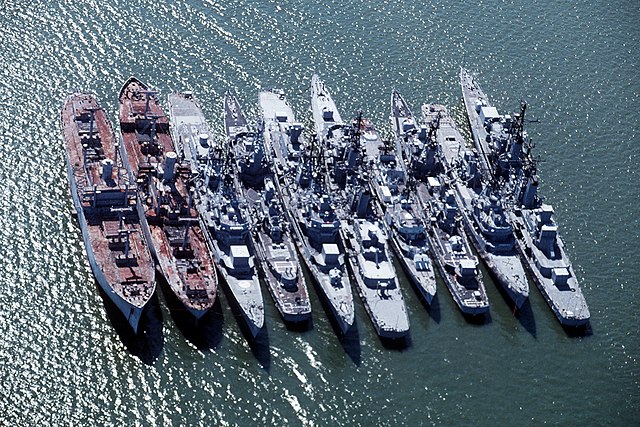
Destroyers mothballed on the James River, 1993; nice sample of all cold war classes.
links
https://www.secretprojects.co.uk/threads/u-s-navy-typhon-warships.690/page-2
https://www.globalsecurity.org/military/systems/ship/cgn-typhon.htm
https://www.globalsecurity.org/military/systems/ship/cgn-typhon.htm



 Latest Facebook Entry -
Latest Facebook Entry -  X(Tweeter) Naval Encyclopedia's deck archive
X(Tweeter) Naval Encyclopedia's deck archive Instagram (@navalencyc)
Instagram (@navalencyc)





 French Navy
French Navy Royal Navy
Royal Navy Russian Navy
Russian Navy Armada Espanola
Armada Espanola Austrian Navy
Austrian Navy K.u.K. Kriegsmarine
K.u.K. Kriegsmarine Dansk Marine
Dansk Marine Nautiko Hellenon
Nautiko Hellenon Koninklije Marine 1870
Koninklije Marine 1870 Marinha do Brasil
Marinha do Brasil Osmanlı Donanması
Osmanlı Donanması Marina Do Peru
Marina Do Peru Marinha do Portugal
Marinha do Portugal Regia Marina 1870
Regia Marina 1870 Nihhon Kaigun 1870
Nihhon Kaigun 1870 Preußische Marine 1870
Preußische Marine 1870 Russkiy Flot 1870
Russkiy Flot 1870 Svenska marinen
Svenska marinen Søværnet
Søværnet Union Navy
Union Navy Confederate Navy
Confederate Navy Armada de Argentina
Armada de Argentina Imperial Chinese Navy
Imperial Chinese Navy Marinha do Portugal
Marinha do Portugal Mexico
Mexico Kaiserliche Marine
Kaiserliche Marine 1898 US Navy
1898 US Navy Sovietskiy Flot
Sovietskiy Flot Royal Canadian Navy
Royal Canadian Navy Royal Australian Navy
Royal Australian Navy RNZN Fleet
RNZN Fleet Chinese Navy 1937
Chinese Navy 1937 Kriegsmarine
Kriegsmarine Chilean Navy
Chilean Navy Danish Navy
Danish Navy Finnish Navy
Finnish Navy Hellenic Navy
Hellenic Navy Polish Navy
Polish Navy Romanian Navy
Romanian Navy Turkish Navy
Turkish Navy Royal Yugoslav Navy
Royal Yugoslav Navy Royal Thai Navy
Royal Thai Navy Minor Navies
Minor Navies Albania
Albania Austria
Austria Belgium
Belgium Columbia
Columbia Costa Rica
Costa Rica Cuba
Cuba Czechoslovakia
Czechoslovakia Dominican Republic
Dominican Republic Haiti
Haiti Hungary
Hungary Honduras
Honduras Estonia
Estonia Iceland
Iceland Eire
Eire Equador
Equador Iran
Iran Iraq
Iraq Latvia
Latvia Liberia
Liberia Lithuania
Lithuania Mandchukuo
Mandchukuo Morocco
Morocco Nicaragua
Nicaragua Persia
Persia San Salvador
San Salvador Sarawak
Sarawak Uruguay
Uruguay Venezuela
Venezuela Zanzibar
Zanzibar Warsaw Pact Navies
Warsaw Pact Navies Bulgaria
Bulgaria Hungary
Hungary

 Bundesmarine
Bundesmarine Dutch Navy
Dutch Navy Hellenic Navy
Hellenic Navy Marina Militare
Marina Militare Yugoslav Navy
Yugoslav Navy Chinese Navy
Chinese Navy Indian Navy
Indian Navy Indonesian Navy
Indonesian Navy JMSDF
JMSDF North Korean Navy
North Korean Navy Pakistani Navy
Pakistani Navy Philippines Navy
Philippines Navy ROKN
ROKN Rep. of Singapore Navy
Rep. of Singapore Navy Taiwanese Navy
Taiwanese Navy IDF Navy
IDF Navy Saudi Navy
Saudi Navy Royal New Zealand Navy
Royal New Zealand Navy Egyptian Navy
Egyptian Navy South African Navy
South African Navy






























 Ukrainian Navy
Ukrainian Navy dbodesign
dbodesign